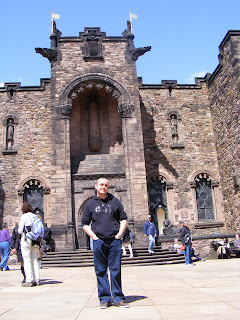Edinburgh Castle
Edinburgh Castle is a fortress which dominates the skyline of the city of Edinburgh, from its position atop the volcanic Castle Rock.
Entrance gate:
City overviews:
Human habitation of the site is dated back as far as the 9th century BC, although the nature of early settlement is unclear. There has been a royal castle here since at least the reign of David I in the 12th century, and the site continued to be a royal residence until the Union of the Crowns in 1603. From the 15th century the castle's residential role declined, and by the 17th century its principal role was as a military base with a large garrison.
Looking at the views:
Few of the present buildings pre-date the Lang Siege of the 16th century, when the medieval fortifications were largely destroyed by artillery bombardment. The notable exception is St Margaret’s Chapel, the oldest surviving building in Edinburgh, which dates from the early 12th century. Among other significant buildings of the castle are the Royal Palace, and the early-16th-century Great Hall. The castle also houses the Scottish National War Memorial.
National War Museum:
The great hall:
Royal Place building holding the Scottish crown Jewels: Photo: 400; 412
Although formally owned by the Ministry of Defence, most of the castle is now in the care of Historic Scotland. The garrison left in the 1920s, but there is still a military presence at the castle, largely ceremonial and administrative, and including a number of regimental museums. It is the backdrop to the annual Edinburgh Military Tattoo and has become a recognisable symbol of Edinburgh and of Scotland.
Castle Prison: Photo: 418;
The One O’clock Gun: is a time signal time, and is fired every day at precisely 13:00, excepting Sunday, Good Friday and Christmas Day. The gun was established in 1861 as a time signal for ships in the Firth of Forth, and complemented the time ball, which was installed on the Nelson Monument in 1852, but which was useless during foggy weather. The gun could easily be heard by ships in Leith Harbour, 2 miles (3.2 km) away.

















No comments:
Post a Comment